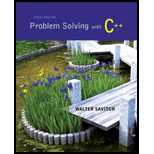
Write a rational number class. This problem will be revisited in Chapter 11, where operator overloading will make the problem much easier. For now we will use member functions add, sub, mul, div, and less that each carry out the operations +, -, *, /, and <. For example, a + b will be written a.add(b), and a < b will be written a.less(b).
Define a class for rational numbers. A rational number is a “ratio-nal” number, composed of two integers with division indicated. The division is not carried out, it is only indicated, as in 1/2, 2/3, 15/32, 65/4, 16/5. You should represent rational numbers by two int values, numerator and denominator.
A principle of abstract data type construction is that constructors must be present to create objects with any legal values. You should provide constructors to make objects out of pairs of int values; this is a constructor with two int parameters. Since every int is also a rational number, as in 2/1 or 17/1, you should provide a constructor with a single int parameter. Provide member functions input and output that take an istream and ostream argument, respectively, and fetch or write rational numbers in the form 2/3 or 37/51 to or from the keyboard (and to or from a file). Provide member functions add, sub, mul, and div that return a rational value. Provide a function less that returns a bool value. These functions should do the operation suggested by the name. Provide a member function neg that has no parameters and returns the negative of the calling object.
Provide a main function that thoroughly tests your class implementation.
The following formulas will be useful in defining functions.
| a/b + c/d = (a * d + b * c) / (b * d) a/b − c/d = (a * d − b * c) / (b * d) (a/b) * (c/d) = (a * c) / (b * d) (a/b) / (c/d) = (a * d) / (c * b) −(a/b) = (−a/b) (a/b) < (c/d) means (a * d) < (c * b) (a/b) == (c/d) means (a * d) == (c * b) |
Let any sign be carried by the numerator; keep the denominator positive.
Trending nowThis is a popular solution!

Chapter 10 Solutions
Problem Solving with C++ plus MyProgrammingLab with Pearson eText-- Access Card Package (9th Edition)
Additional Engineering Textbook Solutions
Degarmo's Materials And Processes In Manufacturing
Concepts Of Programming Languages
Starting Out with Java: From Control Structures through Objects (7th Edition) (What's New in Computer Science)
Introduction To Programming Using Visual Basic (11th Edition)
HEAT+MASS TRANSFER:FUND.+APPL.
Web Development and Design Foundations with HTML5 (8th Edition)
- Complete the JavaScript function addPixels () to calculate the sum of pixelAmount and the given element's cssProperty value, and return the new "px" value. Ex: If helloElem's width is 150px, then calling addPixels (hello Elem, "width", 50) should return 150px + 50px = "200px". SHOW EXPECTED HTML JavaScript 1 function addPixels (element, cssProperty, pixelAmount) { 2 3 /* Your solution goes here *1 4 } 5 6 const helloElem = document.querySelector("# helloMessage"); 7 const newVal = addPixels (helloElem, "width", 50); 8 helloElem.style.setProperty("width", newVal); [arrow_forwardSolve in MATLABarrow_forwardHello please look at the attached picture. I need an detailed explanation of the architecturearrow_forward
- Information Security Risk and Vulnerability Assessment 1- Which TCP/IP protocol is used to convert the IP address to the Mac address? Explain 2-What popular switch feature allows you to create communication boundaries between systems connected to the switch3- what types of vulnerability directly related to the programmer of the software?4- Who ensures the entity implements appropriate security controls to protect an asset? Please do not use AI and add refrencearrow_forwardFind the voltage V0 across the 4K resistor using the mesh method or nodal analysis. Note: I have already simulated it and the value it should give is -1.714Varrow_forwardResolver por superposicionarrow_forward
- Describe three (3) Multiplexing techniques common for fiber optic linksarrow_forwardCould you help me to know features of the following concepts: - commercial CA - memory integrity - WMI filterarrow_forwardBriefly describe the issues involved in using ATM technology in Local Area Networksarrow_forward
- For this question you will perform two levels of quicksort on an array containing these numbers: 59 41 61 73 43 57 50 13 96 88 42 77 27 95 32 89 In the first blank, enter the array contents after the top level partition. In the second blank, enter the array contents after one more partition of the left-hand subarray resulting from the first partition. In the third blank, enter the array contents after one more partition of the right-hand subarray resulting from the first partition. Print the numbers with a single space between them. Use the algorithm we covered in class, in which the first element of the subarray is the partition value. Question 1 options: Blank # 1 Blank # 2 Blank # 3arrow_forward1. Transform the E-R diagram into a set of relations. Country_of Agent ID Agent H Holds Is_Reponsible_for Consignment Number $ Value May Contain Consignment Transports Container Destination Ф R Goes Off Container Number Size Vessel Voyage Registry Vessel ID Voyage_ID Tonnagearrow_forwardI want to solve 13.2 using matlab please helparrow_forward
 C++ Programming: From Problem Analysis to Program...Computer ScienceISBN:9781337102087Author:D. S. MalikPublisher:Cengage Learning
C++ Programming: From Problem Analysis to Program...Computer ScienceISBN:9781337102087Author:D. S. MalikPublisher:Cengage Learning C++ for Engineers and ScientistsComputer ScienceISBN:9781133187844Author:Bronson, Gary J.Publisher:Course Technology Ptr
C++ for Engineers and ScientistsComputer ScienceISBN:9781133187844Author:Bronson, Gary J.Publisher:Course Technology Ptr EBK JAVA PROGRAMMINGComputer ScienceISBN:9781337671385Author:FARRELLPublisher:CENGAGE LEARNING - CONSIGNMENT
EBK JAVA PROGRAMMINGComputer ScienceISBN:9781337671385Author:FARRELLPublisher:CENGAGE LEARNING - CONSIGNMENT Microsoft Visual C#Computer ScienceISBN:9781337102100Author:Joyce, Farrell.Publisher:Cengage Learning,
Microsoft Visual C#Computer ScienceISBN:9781337102100Author:Joyce, Farrell.Publisher:Cengage Learning,



